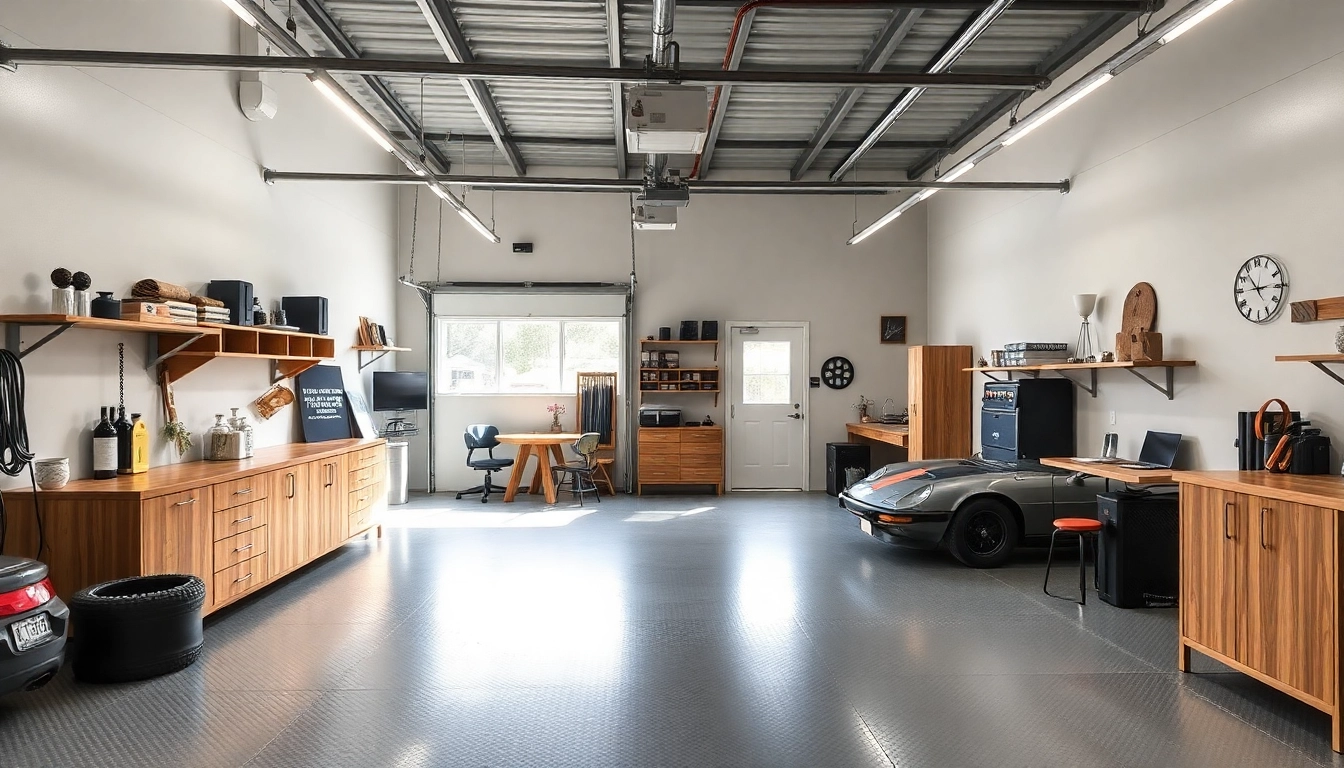Introduction to Custom Garages
Custom garages are not merely spaces to store vehicles; they represent a unique blend of functionality and personal expression. As homeowners increasingly seek ways to enhance their properties, custom garages have emerged as a desirable addition. These structures can be tailored to fit individual needs, aesthetics, and local regulations. Whether you need extra storage, a hobby workshop, or a stylish entry to your home, custom garages provide numerous options. This article delves into the world of custom garages, exploring their definitions, benefits, design trends, cost factors, and regulatory considerations.
What are Custom Garages?
At its core, a custom garage is a tailored space designed specifically to meet the unique requirements of the homeowner. Unlike standard garages, which typically follow a predefined structure or size, custom garages can vary significantly in dimensions, materials, layout, and function. Whether you need a compact garage for a single car or a sprawling space that includes a workshop, storage for tools, and even a lounge area, customization is key.
This versatility is further enhanced by various styles—such as contemporary, traditional, rustic, or modern designs—allowing homeowners to select a garage that complements their home’s architecture. Custom garages can be detached or attached to the main house, providing additional design flexibility.
Benefits of Custom Garages
Choosing a custom garage brings forth a myriad of benefits that enhance property value, functionality, and lifestyle. Here are some key advantages:
- Increased Property Value: A well-designed custom garage enhances the overall value of your property, making it more appealing to potential buyers.
- Functionality: You have the freedom to design the layout that suits your lifestyle. Whether you need extra storage, a workshop, or a recreational space, a custom garage can accommodate it.
- Aesthetic Appeal: Custom garages can be designed to match the design ethos of your home, improving your property’s curb appeal.
- Durability: By selecting quality materials and construction methods, you can ensure that your garage withstands the elements and lasts for many years.
- Maximized Use of Space: Custom garages allow you to utilize every inch effectively, accommodating tools, vehicles, and other necessities without cluttering your home.
Popular Styles and Designs
The demand for custom garages has led to a wide variety of styles and designs being employed in residential settings. Here are some popular options:
- Traditional: Featuring gabled roofs and classic details, traditional garages blend seamlessly with older homes.
- Modern: Defined by clean lines and minimalist aesthetics, modern garages often incorporate large windows and sleek finishes.
- Rustic: Utilizing materials such as wood and stone, rustic designs create a warm and inviting atmosphere, ideal for country homes.
- Industrial: Combining metal and concrete, industrial-style garages reflect a raw, edgy aesthetic that is increasingly popular in urban environments.
- Multi-Car Garages: These are designed to accommodate two or more vehicles, often featuring additional storage space or integrated workshops.
Cost Factors in Building Custom Garages
When contemplating a custom garage project, understanding the cost factors involved is critical for effective budgeting and planning. The costs can shift based on various variables, including size, materials, and design complexity.
Understanding Budget Considerations
Budgeting for a custom garage involves estimating construction costs, material expenses, and additional features. A ballpark figure suggests that building a custom garage can range from $20,000 to over $50,000, which includes:
- Materials: Choose between wood, metal, or brick—each material has a different cost and longevity.
- Labor: Hiring professional contractors adds to the overall price, although DIY options can reduce costs significantly.
- Design and Planning: Custom designs typically require hiring an architect or designer, which increases upfront costs but may lead to a better, more functional result.
Comparative Costs: DIY vs Professional Builders
A significant decision for homeowners is whether to enlist professional builders or embark on a DIY project. DIY projects can pose savings opportunities; however, they often come with risks, especially for those lacking construction experience. Professional builders bring expertise and efficiency, ensuring adherence to local building codes and quality craftsmanship. While their costs can be higher, they can mitigate unexpected issues that a DIY builder might face.
Ultimately, the best choice depends on the homeowner’s skill level, budget, and the project’s complexity.
Hidden Expenses to Expect
While homeowners may budget for direct costs, several hidden expenses can arise during the custom garage building process. These include:
- Site Preparation: Clearing the land, excavation, and grading may be necessary before construction begins.
- Permits and Inspections: Local regulations may require permits, inspections, and other compliance measures that incur additional fees.
- Landscaping: Post-construction landscaping, including pathways and plantings, may require significant investment.
- Utilities Installation: If the garage includes electrical outlets, heating, or cooling options, these installations can add up quickly.
Designing Your Custom Garage
Effective design is at the heart of creating a personalized garage that meets your specific needs. Thoughtful planning extends beyond aesthetics, as it also enhances functionality.
Planning Your Space Efficiently
Planning your custom garage intends to maximize the available space while addressing your specific functional needs. A well-structured layout is crucial for a garage that serves multiple purposes. Here are some tips for designing an efficient garage:
- Use Vertical Space: Wall-mounted storage options, such as shelving or pegboards, can free up floor area.
- Designate Zones: Clearly define areas for parking, storage, and workspace to streamline the garage’s function and enhance usability.
- Plan for Traffic Flow: Ensure your layout allows for easy access to vehicles and tools, avoiding cluttered pathways.
Essential Features to Consider
When designing your custom garage, consider integrating features that enhance its functionality and look. Here are some key features to think about:
- Storage Solutions: Built-in cabinets, shelves, and hanging organizers can keep tools and supplies neatly stored.
- Workstations: For those who work on DIY projects or repairs, a dedicated workspace with a sturdy workbench is essential.
- Lighting: Proper lighting, including natural light from windows and overhead lighting, is vital for a workspace.
- Heating/Cooling Options: If you intend to spend significant time in the garage, consider installing heating or cooling systems for comfort.
Incorporating Personal Touches
Customization allows you to add personal touches that reflect your tastes and enhance functionality. Consider the following:
- Color Schemes: Choose colors that complement your home and reflect your style.
- Flooring Options: Select durable flooring solutions, such as epoxy, tiles, or polished concrete, that fit your aesthetic preferences and usage needs.
- Decorative Elements: Adding custom artwork, signage, or memorabilia can create a unique ambiance.
Regulations and Permits
Building a custom garage is a significant home improvement project that often requires navigating local regulations and building codes. Understanding the legal landscape is crucial to ensure compliance and avoid costly fines.
Understanding Local Building Codes
Local building codes dictate the standards for construction, including structural integrity, safety measures, and zoning laws. Before beginning construction on a custom garage, familiarize yourself with these codes, which can vary significantly between municipalities. Key elements include:
- Height Restrictions: Many areas have regulations regarding the maximum height of structures.
- Setback Requirements: These rules dictate how far back your garage must be from the property line.
- Permitted Uses: Some regions may restrict what activities can take place in a garage (e.g., residential storage vs. a business operation).
Applying for Necessary Permits
Most jurisdictions require permits for new construction, including garages. The process generally involves submitting your plans to a local permitting office, paying applicable fees, and potentially undergoing inspections during and after construction. Follow these steps:
- Prepare Your Plans: Detailed architectural plans are often needed to apply for a permit.
- Complete the Application: This usually involves filling out a form and submitting your plans with the correct documentation.
- Pay Fees: Expect to pay various fees related to processing the permit and possible inspections.
Working with Local Authorities
Effective communication with local authorities is crucial. Maintain transparency about your project and engage with inspectors or city planners to gain insights and guidance. This proactive approach can prevent missteps and ensure a smooth permitting process.
Showcase of Stunning Custom Garages
Visual inspiration is vital for any homeowner embarking on a custom garage project. Here are recent trends, real-life projects, and before-and-after transformations that exemplify the beauty and functionality of custom garages.
Recent Trends and Innovations
Custom garages have seen notable design trends in recent years, reflecting broader shifts in home design and lifestyle needs. Some trends include:
- Smart Technology: Incorporating IoT devices for enhanced security and functionality, such as app-controlled doors and environmental controls.
- Sustainable Materials: Eco-friendly materials are increasingly preferred, helping reduce the environmental footprint of home construction.
- Combining Spaces: Many homeowners combine garage space with other functional areas, such as a small gym or workshop, promoting versatility.
Real-life Custom Garage Projects
Examining real-life custom garage projects can provide insights into design possibilities. Some examples include:
- Luxury Garages: Featuring high-end finishes and unique architecture, these garages serve as a statement piece for wealthy homeowners.
- Functional Workshops: Many homeowners have converted garages into workshops complete with specialized storage and work surfaces for hobbies.
- Family-friendly Spaces: Some garages double as recreational areas with game rooms or kid-friendly zones.
Before and After Transformations
Transforming a standard garage into a custom space can provide dramatic results. Documenting before and after changes can offer visual inspiration and demonstrate how thoughtful design can lead to significant improvements. These transformations often showcase:
- Enhanced Lighting: Adding large windows or skylights can radically change the ambiance.
- Improved Organization: Comprehensive shelving and storage solutions create an organized and functional space.
- Updated Aesthetics: Fresh paint, flooring, and design elements can modernize a dated structure.



